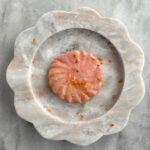blood orange stamped shortbread cookies
These stamped, buttery shortbread cookies are deliciously crisp and covered in a vanilla blood orange glaze (which gives them an upscale creamsicle vibe).
Ingredients
The Cookies
226g (1 cup) unsalted butter
1 tsp Diamond Crystal kosher salt
100g (1/2 cup) granulated sugar
zest from one blood orange, optional
1 tsp vanilla bean paste or extract
270g (2 1/4 cup) all purpose flour
The Glaze
120g (1 cup) powdered sugar
14g (1 Tbsp) unsalted butter, melted and cooled
1–2 Tbsp fresh squeezed blood orange juice
1 tsp vanilla bean paste or extract
zest of one blood orange
1/4 tsp Diamond Crystal kosher salt (or 1/8 tsp regular table salt)
Instructions
Preheat the oven to 350 F.
To a mixing bowl, add the room temperature butter, salt, granulated sugar, and the orange zest. Mix on medium-low speed to cream the mixture. It should be lightened and completely mixed with no lumps of butter. You don’t need to cream it to be light and fluffy like you would if you were making a cake.
Add the vanilla and mix just until combined. Add the flour all at once and mix until combined. Scrape down the sides to make sure there are no lumps of flour or bits of butter.
Drop dough onto a lightly floured piece of parchment paper. Gently press the dough into a thick rectangle, smoothing the sides of the dough. Sprinkle flour on the dough and place a second piece of parchment paper on top. Roll out the dough with a rolling pin fitted with guides set to 1/4″ or 1/6″. Stamps tend to work better with dough rolled to 1/4″, but I prefer the texture of a 1/6″ rolled cookie. I found that wiggling while pressing the stamp into the dough and stamping room temperature dough solved the problem of using the thinner rolled dough.
Once the dough has been rolled, immediately peel off the top layer of parchment. If there is any visible stickiness, sprinkle some flour over the surface and gently brush it off with your hand. If the dough is extremely flexible and sticky, pop it in the fridge for a half an hour. (It shouldn’t need fridge time at this stage, though.)
Dip your cookie stamp into flour before pressing into the surface of the dough. Press firmly and wiggle the base of the stamp into the dough to make sure that the entire surface of the stamp is in contact with the dough inside the stamp.
Don’t be alarmed, but the first stamp is sometimes a dud. If you find that the first stamped cookie gets stuck in the stamp, simply remove the dough and set it to the side for when it’s time to re-roll the dough. To remove the dough, use a cocktail pick, toothpick, or a cake tester. Dip the stamp in flour, making sure that flour is evenly coating the stamp with no bare areas and no large clumps of flour. Stamp again, continuing through the entire sheet of dough until there is no more open space. Dip the stamp in flour before stamping each time.
Use a 2 1/2″ round cookie cutter to cut the stamped shapes from the dough. Use an offset spatula to gently pick them up from the parchment and transfer them to a parchment lined baking sheet. (Make sure you line your pan with the parchment paper you peeled off the top of the dough rather than getting a new piece.)
Re-roll your dough another time or two. This recipe makes around two dozen cookies, give or take depending on how thick you roll your dough. I got about thirty cookies rolled at 1/6″ with re-rolling a couple of times.
Freeze the sheet of cookies for five minutes before baking, just to help them retain their shape. Bake for 15-17 minutes for a crisp texture with golden brown bottoms. (The best flavor comes from a golden brown bottom!) Allow the cookies to cool slightly on the pan for a couple of minutes before transferring to a wire rack to cool completely.
While the cookies are baking, make the glaze. Sift the powdered sugar into a small bowl and add the rest of the ingredients. I like to keep the pulp in the juice so there are bits of red throughout the glaze. Stir it together until it is smooth and the powdered sugar is completely mixed in.
Use a pastry brush to brush the glaze over the cookies. I like to double glaze them with the leftover glaze to make the glaze a bit thicker on the cookie.
Allow the glaze to set before storing in an airtight container.
